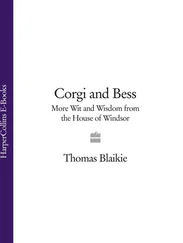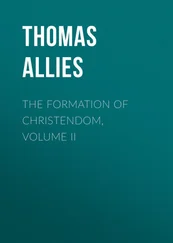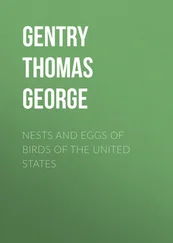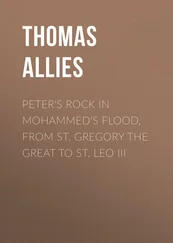Thomas Allies - Church and State as Seen in the Formation of Christendom
Здесь есть возможность читать онлайн «Thomas Allies - Church and State as Seen in the Formation of Christendom» — ознакомительный отрывок электронной книги совершенно бесплатно, а после прочтения отрывка купить полную версию. В некоторых случаях можно слушать аудио, скачать через торрент в формате fb2 и присутствует краткое содержание. ISBN: , Жанр: foreign_antique, foreign_prose, Историческая проза, на английском языке. Описание произведения, (предисловие) а так же отзывы посетителей доступны на портале библиотеки ЛибКат.
- Название:Church and State as Seen in the Formation of Christendom
- Автор:
- Жанр:
- Год:неизвестен
- ISBN:http://www.gutenberg.org/ebooks/38537
- Рейтинг книги:4 / 5. Голосов: 1
-
Избранное:Добавить в избранное
- Отзывы:
-
Ваша оценка:
- 80
- 1
- 2
- 3
- 4
- 5
Church and State as Seen in the Formation of Christendom: краткое содержание, описание и аннотация
Предлагаем к чтению аннотацию, описание, краткое содержание или предисловие (зависит от того, что написал сам автор книги «Church and State as Seen in the Formation of Christendom»). Если вы не нашли необходимую информацию о книге — напишите в комментариях, мы постараемся отыскать её.
Church and State as Seen in the Formation of Christendom — читать онлайн ознакомительный отрывок
Ниже представлен текст книги, разбитый по страницам. Система сохранения места последней прочитанной страницы, позволяет с удобством читать онлайн бесплатно книгу «Church and State as Seen in the Formation of Christendom», без необходимости каждый раз заново искать на чём Вы остановились. Поставьте закладку, и сможете в любой момент перейти на страницу, на которой закончили чтение.
Интервал:
Закладка:
No one can study the vision and its interpretation without seeing that the fabric of a great temporal empire, whose ruler is called a king of kings, and whose seat is the city wherein Nimrod, “the great hunter before the Lord,” set up the first kingdom, to stand for ever at the head of human history a kingdom symbolical not of justice but of force, is therein contrasted with the fabric of a kingdom which the God of heaven should set up. And it is specially noted that He should set up this kingdom in the times of the empires denoted by the statue. And of the kingdom so to be set up four things are predicated in, as it were, an ascending scale. First, there is its divine institution: “the God of heaven shall set up a kingdom,” and that in a manner wholly unexampled, which is expressed by “a stone cut out of a mountain without hands.” Secondly, “the kingdom shall never be destroyed.” Thirdly, and further, “it shall not be delivered up to another people;” a process which, according to the interpretation of the vision, was to take place three times in the empires represented by the statue. Fourthly, “that it should break in pieces and consume all these kingdoms, while itself should last for ever.”
Moreover, as the earthly kingdom was really a kingdom, so the force of the similitude running through the whole, and heightened by the effect of contrast, declares that the heavenly should be a kingdom. As the seat of the earthly kingdom was this world, so evidently the seat of the heavenly is this same world. As the earthly kingdom should be destroyed, so the heavenly should be exempt from destruction. As the earthly kingdom was to pass from one people to another, so the heavenly kingdom should not pass from one people to another. But then comes a culmination which no one could anticipate. For not only is there an antagonism between the earthly and the heavenly kingdom, but by force of it, and in consequence of it, the heavenly should consume and break in pieces the earthly. Whereby the hearer is given to understand that the earthly kingdom, terrible and grand and all-powerful as it seemed to be, was created for the sake of the heavenly, which in due time should be set up in it, but not of it nor from it.
It is no less implied through the whole tenor of the vision that the authority which constitutes the essence of a kingdom – that is, supreme and independent authority, which is expressed in legislation and administered in government – subsists as much in the heavenly as in the earthly kingdom, with this marked distinction, that it is transitory in the one case and permanent in the other.
And, finally, the power by which all this should be done was something beyond human power, and without parallel, very strange and astonishing, “a stone cut out of a mountain without hands,” which should not only strike the statue upon its feet, but itself grow, “until it became a great mountain, and filled the whole earth.”
Thus the filling of the whole earth with the stone which struck the statue and then became a great mountain terminates the vision. But it is no less its scope and object. The statue exists before that the stone may come after. The statue and the stone, as thus exhibited, indicate the respective value in the divine counsels of the powers which they represent; that is, the subordination of the human kingdom to the divine, both in the order of causality and in duration, is distinctly laid down. And the end of both accords with this. The great statue, when struck by the stone, became like the chaff of a summer’s threshing-floor; but the stone which struck it filled the whole earth. And the vision leaves it in possession.
The vision also reaches from end to end. It begins with the first empire, which is human, and runs back by the place in which it is seated to the commencement of actual things; and it ends with the last, which is divine, and which shall consume all the other kingdoms recorded, and itself last for ever. Thus the vision grasps the whole organism of society in the human race, as it lies unrolled before the providence of God.
Such was the prophecy. Now let us pass over a thousand years, and take the first fulfilment of the vision as it presented itself to an ancient saint at the beginning of the fifth century. We will only note that in the interval Nabuchodonosor and Cyrus and Alexander and Cæsar had set up the four world-empires. They were four indeed, for they passed three times from one people to another – from Chaldean to Persian, from Persian to Grecian, from Grecian to Roman, as the variety of metals in the statue was interpreted to mean. Yet were they also one – a unity which, as that of a single person, the great statue so faithfully represented. For they were one with each other in the character and unbroken tradition of the same civilisation, and in the principle of their authority, which was conquest. They were filled with the same spirit of heathen domination, which was in truth the voice and the power of a false worship, as with the spirit of one man who rose in Babylon to set in Rome. 1 1 “Dentro dal monte sta dritto un gran veglio, Che tiene volte le spalle inver Damiata, E Roma guarda sì, come suo speglio.” – Dante, Inferno , 14, 101.
Two Apostles, special friends and constant fellow-workers, had marked this identity by giving the mystical name of Babylon to heathen Rome – St. Peter 2 2 1 Pet. v. 13; Apocal. xvii. 18, xviii. 2, 20.
in the epistle which he dates from Babylon, St. John in his vision of the woman drunk with the blood of saints and martyrs, and seated upon the seven hills, whom he himself interprets to be “the great city which had kingdom over the kings of the earth.” These empires had run their appointed course, and the last and greatest of them, which was likewise the heir and successor of the three preceding in power and thought, as well as in the body of their territories and the soul which ruled therein, was ending in disgrace and dissolution. For at length the tribes of the North had broken through the long-guarded frontiers of Roman power. Alaric with his Goths had taken Rome, and a deep cry of distress arose through all the vast provinces of her empire. Every city in that wide domain trembled with the sense of insecurity for the present and fear for the future which the fall of Rome inspired. Just at this moment the great Western Father, whose voice sounded like the voice of the Church herself, wrote thus to a heathen inquirer: —
Интервал:
Закладка:
Похожие книги на «Church and State as Seen in the Formation of Christendom»
Представляем Вашему вниманию похожие книги на «Church and State as Seen in the Formation of Christendom» списком для выбора. Мы отобрали схожую по названию и смыслу литературу в надежде предоставить читателям больше вариантов отыскать новые, интересные, ещё непрочитанные произведения.
Обсуждение, отзывы о книге «Church and State as Seen in the Formation of Christendom» и просто собственные мнения читателей. Оставьте ваши комментарии, напишите, что Вы думаете о произведении, его смысле или главных героях. Укажите что конкретно понравилось, а что нет, и почему Вы так считаете.












